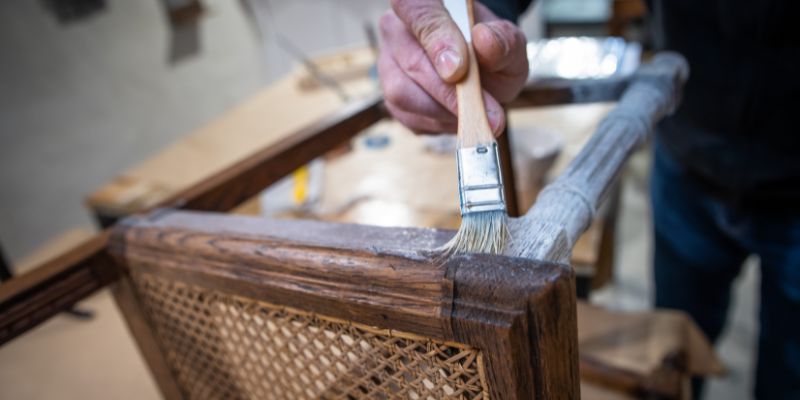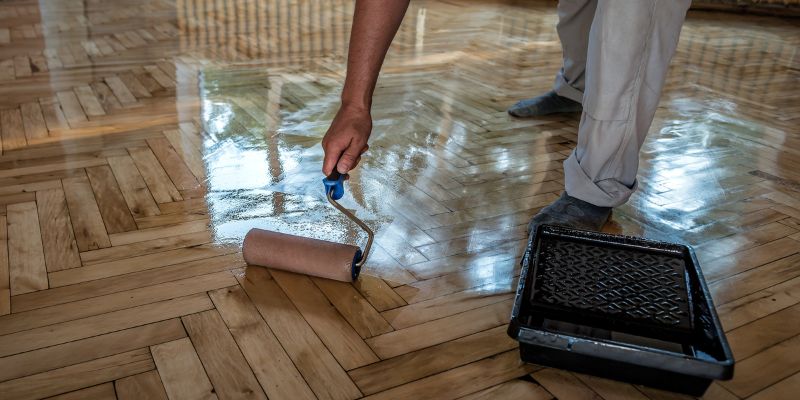To use Restore a Finish, first, clean the surface to remove any dirt or debris. Then, apply the Restore a Finish evenly using a soft cloth, following the wood grain.
Let it sit for a few minutes, and then wipe off the excess with a clean cloth. Now you can restore the beauty of your wood furniture effortlessly! Introducing Restore a Finish, a simple and effective solution to reviving the beauty of your wood furniture.
Over time, daily wear and tear can leave your beloved pieces looking dull and worn. However, with Restor a Finish, you can bring back the original luster and shine without the hassle and cost of refinishing. This versatile product can be used on a wide range of wood surfaces, from furniture to cabinets, and even flooring. In just a few easy steps, you can transform your worn-out wood into a stunning centerpiece in your home. So, let’s discover how to use Restore a Finish and enjoy the remarkable results it offers.
Getting Started With Restor A Finish
Are you looking to restore the beauty of your worn-out furniture? Restore a Finish is the perfect solution for you. This all-in-one product brings back the luster and color to faded or dull wood surfaces. But how do you go about using Restore a Finish? Let’s dive into the process and get started with this amazing product.
Choosing The Right Product
Before you begin with the restoration process, it’s important to choose the right Restor Finish product for your specific needs. Restore a Finish comes in various colors, so be sure to pick the shade that matches your furniture’s existing finish. Whether you need to darken, lighten, or maintain the current color, there’s a Restor a Finish option for you. Make sure you read the product labels and descriptions for a complete understanding of each shade.
Gathering Necessary Supplies
Now that you have the right Restor a Finish product, it’s time to gather the necessary supplies. Here’s a checklist of items you’ll need:
- Clean, lint-free cloths
- Steel wool pads (0000 grade)
- Mineral spirits or denatured alcohol
- Disposable gloves
- Protective eyewear
Having these supplies readily available will help streamline the restoration process and ensure you’re well-prepared.

Preparing The Surface For Restoration
Before you begin using Restore a Finish on your furniture, it is essential to properly prepare the surface. Taking the time to clean the surface and assess the damage will ensure the best results and help you achieve a professional-looking restoration.
Cleaning The Surface
The first step in preparing the surface for restoration is cleaning it thoroughly. Dirt, grime, and other debris can prevent the Restor a Finish from adhering properly, resulting in an uneven finish. Use a mild soap and water solution or a specialized wood cleaner to remove any dirt and buildup. Avoid using harsh chemicals or abrasive cleaners that can damage the wood.
Here is a simple step-by-step process for cleaning the surface:
- Prepare a mixture of mild soap and warm water in a bucket.
- Dampen a soft cloth or sponge with the soapy solution.
- Gently scrub the entire surface, paying extra attention to any stubborn stains or spots.
- Rinse the cloth or sponge and wipe away any excess soap residue.
- Dry the surface with a clean, lint-free cloth.
Assessing The Damage
After cleaning the surface, the next step is to assess the damage. This will help you determine the appropriate approach for restoration and identify any repairs that may be required.
Examine the surface closely, looking for the following:
- Scratches and gouges: Assess the severity of any scratches or gouges. Minor scratches can often be easily fixed with Restor a Finish, while deeper gouges may require additional repair techniques.
- Water damage: Look for signs of water damage, such as discoloration, warping, or mold. If the damage is extensive, consult a professional to ensure proper restoration.
- Worn or faded areas: Identify areas where the finish has worn off or faded due to age or sun exposure. These areas can be revitalized with Restor a Finish.
- Loose or damaged veneer: Inspect the veneer to check for any loose or damaged sections. If the veneer is significantly compromised, it may require re-gluing or replacement.
Once you have assessed the damage, make a note of the areas that need attention. This will help guide your restoration process and ensure that you address all the necessary repairs and enhancements.
Application Techniques For Restor A Finish
When it comes to restoring the finish of your furniture, knowing the proper application techniques for restoring a Finish is essential. By using the product correctly and understanding how to deal with tough stains, you can revitalize and enhance the appearance of your wood surfaces. Here, we’ll discuss the key application techniques for Restor a Finish to help you achieve professional results.
Applying The Product Correctly
To apply Restore a Finish effectively, start by cleaning the surface with a soft cloth and mineral spirits to remove any dirt or grime. Once the surface is clean and dry, shake the product well and apply it generously using a soft, lint-free cloth. Follow the wood grain and consistently rub the product into the surface, allowing it to penetrate and revitalize the finish. After a few minutes, wipe off any excess product with a clean cloth and let it dry for at least 24 hours before applying a protective finish.
Dealing With Tough Stains
For tough stains, such as water rings or heat marks, lightly sand the affected area with fine-grade steel wool to remove the blemish. Then, apply the Restore a Finish using the same technique as mentioned earlier. If the stain persists, you can use the matching Howard Restor-A-Finish color instead of the original for a deeper restoration. Remember to always test the product in an inconspicuous area first, and apply with light, even pressure to avoid damaging the wood.
Tips For A Successful Restoration
Restore a Finish is a versatile product that can revitalize and restore the beauty of your furniture. Whether you are looking to repair scratches, watermarks, or faded finishes, following these useful tips can help you achieve a successful restoration.
Matching The Finish
When it comes to restoring furniture, one crucial step is matching the finish. Before you begin, it’s essential to identify the type of finish on your furniture piece. Some common finishes include shellac, lacquer, varnish, or polyurethane.
To determine the type of finish, perform a simple spot test in an inconspicuous area. Apply a small amount of denatured alcohol or lacquer thinner on a cloth and rub it gently on the surface. If the finish softens or dissolves, it is likely shellac. If it remains unaffected, it could be lacquer, varnish, or polyurethane.
Blending And Buffing Techniques
After applying the Restore a Finish, blending and buffing are essential to achieve a seamless result. Blending involves feathering the edges of the restored area into the surrounding finish, creating a natural transition. Use a soft, lint-free cloth dampened with the Restor a Finish to gently rub and blend the restored area with the existing finish.
Next, it’s time for buffing. Using another clean cloth, buff the surface in a circular motion to remove any excess product and create a smooth, glossy finish. This technique helps to distribute the Restore Finish evenly and enhances the shine of the restored area.
Summary
Using Restore a Finish to restore your furniture can bring new life to your pieces. By following these tips, you can match the finish accurately and achieve professional-looking results. Remember to blend and buff the restored area for a seamless and polished finish. With Restor a Finish, your furniture can regain its former beauty and become a focal point in your home once again.
Maintaining And Caring For Restored Surfaces
Once you have successfully restored your surfaces using the Restor a Finish product, it is crucial to maintain and care for them properly. By following a routine maintenance plan and ensuring long-term protection, you can keep your restored surfaces looking their best for years to come.
Routine Maintenance
Implementing a routine maintenance routine is essential for preserving the beauty of your restored surfaces. Here are some simple yet effective tips to keep in mind:
- Regularly dust your surfaces to prevent the buildup of dirt and grime.
- Clean the surfaces with a soft, damp cloth using mild soap and water. Avoid abrasive cleaners that can damage the finish.
- Wipe up any spills immediately to prevent staining.
- Avoid placing hot items directly on the restored surfaces to prevent heat damage.
- Use coasters or placemats under glasses and dishes to protect against scratches and moisture damage.
Long-term Protection
In addition to routine maintenance, providing long-term protection to your restored surfaces is crucial for their longevity. Here are some tips to help you protect your investment:
- Apply a layer of furniture wax or polish to the restored surfaces every few months to maintain their shine and provide an extra layer of protection.
- Use felt pads or furniture glides on the bottom of your furniture legs to prevent scratches when moving them.
- Avoid exposing your restored surfaces to direct sunlight, as UV rays can fade the finish over time. Use curtains or blinds to provide shade if necessary.
- Consider using tablecloths or placemats to protect dining surfaces from scratches and spills.
- If you have restored wooden surfaces, avoid placing them near sources of excessive heat or moisture, such as radiators or humidifiers.
By following these routine maintenance and long-term protection tips, you can ensure that your restored surfaces retain their beauty and withstand the test of time. The Restore a Finish product is a valuable tool for rejuvenating and preserving your surfaces, but proper care and maintenance are key to keeping them looking their best.

Frequently Asked Questions For How To Use Restor A Finish
Do I Need To Sand Before Using Restor-a-finish?
Before using Restor-A-Finish, sanding is not necessary. Simply apply the product directly to the wood’s surface.
Is Restor-a-finish Permanent?
Yes, Restor-A-Finish is a permanent solution for restoring wood finishes.
Why Is Restore A Finish Bad?
Restoring a finish can be bad because it often involves using abrasive materials that can damage the surface of furniture or other items. This can result in a loss of shine, color, and overall aesthetic appeal. It is important to use gentle cleaning methods and seek professional advice for restoring finishes to avoid potential damage.
Can You Put Restore A Finish On Bare Wood?
Yes, you can apply to restore a finish on bare wood to enhance its appearance and protect it.
Conclusion
Restor-A-Finish is a versatile and effective solution for restoring and rejuvenating wood furniture. With its easy application and impressive results, it offers a convenient way to bring new life to old pieces. By following the application tips provided, you can achieve professional-looking outcomes while preserving the beauty of your cherished wood furniture.


